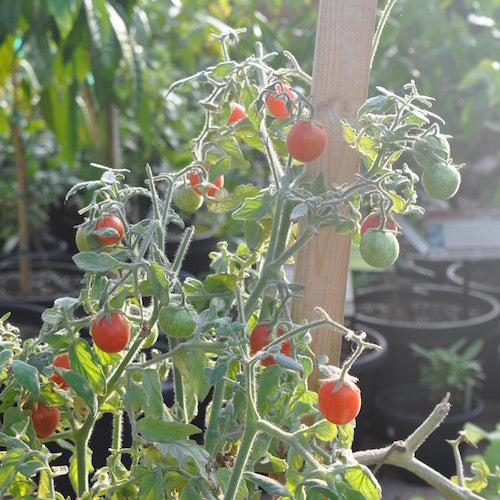Our March 10, 2018 Garden Club was all about growing veggies in containers, and WOW... this topic is obviously one that people are interested in. We had a full house, and then some! Thank you to everyone who came down in person for the workshop; but if you could not make it I thought it would be helpful to review some of the key points.
When it comes to planning your small space / container veggie gardens, there are considerations that make a huge difference to how your garden grows, and thus gardener satisfaction: soil, container style, variety selection, water management and summer nutrients.
SOIL Almost all gardening projects are made easier when a living soil approach is used. That is, be sure your soil has more than just neutral ingredients and includes a good quality compost. There is not much getting around the fact that most commercial potting mixes are very basic and peat-based; but it is also easy to add either home made or commercial compost. This organic matter provides nutrients, but perhaps more importantly compost introduces living soil ecology such as beneficial bacteria and fungi which help plants grow.
Compost is also an ideal ingredient for holding water and slow releasing it out to plants' root systems - very helpful when it comes to container veggies. Some composts, such as Sea Soil (made from composted fish and bark), also contain lots of slow release nutrients; home compost, made from vegetable scraps, has less nutrients but all of the other awesome benefits. A basic container veggie soil recipe is 20-30% compost, 10% worm castings and 60% well drained, organic peat based potting mix.
CONTAINER STYLE First rule of thumb here is the bigger the better. Cute-but-small pots rarely have enough room to support veggies or even leafy herbs through to productive harvest. The minimum depth for most veggie pots is 9 - 11", and deeper for robust species such as full sized tomatoes. Diameter-wise, go as wide as is practical for your space. Big pots can support combination planting; smaller pots are usually best suited to single plants.
Rule two for veggie containers is don't skimp on drainage. This is a non-negotiable, and rocks etc at the bottom of pots will not work to create drainage if actual drainage holes are absent. The only exception is for large pots, where a "slip pot" with drainage may be nested inside, holding the actual soil and plants, while the outer pot can serve as a decorative vessel.
Plastic, terra cotta, geotextile... they all work. Plastic is most forgiving when it comes to drying out; terra cotta breathes well (good for roots) and looks classic - but dries out faster; geotextile pots are quickly becoming popular as they encourage healthy root branching and also allow tons of air into the root zone, but do not dry out as fast as terra cotta (which is a helpful).
VARIETY SELECTION There is nothing harder than trying to force a gigantic plant to thrive in a small pot... but fortunately there are a ton of naturally diminutive veggie selections to choose instead! Look for words like 'dwarf', 'Tom Thumb', 'patio', 'bush' and 'micro' in the names of veggies you want to grow in pots, but don't forget to also check on how tasty your choices are as well (some extra petite veggies lose something on the flavour side, while others "have it all"). At Sage Garden we spend a lot of time evaluating varieties for qualities such as taste + suitability for pots, so we are happy to help you choose good plants.
One interesting project we are involved with is called The Dwarf Tomato Project, which is an active grassroots initiative to select and introduce genuinely tasty, true dwarf tomato plants (we are one of the northern testing locations for this project, and we grow a good number of these unique tomato varieties).
WATER MANAGEMENT Most veggies rely on consistent soil moisture to develop healthy, tasty crops. However, the smaller space and often peaty soils used for pots can seriously undermine the water needs of veggies. Several easy steps can be taken to help manage this problem: add compost to your soil; water deeply at the base of your plants (as opposed to sprinkling water from higher-up); water early in the day; use mulch in your pots (feels a bit weird at first, but super effective!); and check out the many ideas on line for DIY gravity fed watering systems and other innovative ways to easily keep pots correctly watered.
SUMMER NUTRIENTS If you start your container veggie garden off with a healthy living soil, you will not need to use supplemental fertilizer right away. But once the hot, dry weather of July comes along it is really important to feed your plants. The more intensive growing conditions will cause plants to grow faster, using up soil nutrients faster; extra watering during July and August will wash some nutrients out of the soil, so this needs to be replenished; and finally as your crop starts to flower and fruit your plants will have extra nutrient requirements. Fertilizing makes a significant difference at this point. Organic veggie fertilizers are easy to use and cost effective; try Jobes organic slow release veggie spikes if you prefer to apply and forget, or an organic liquid such as Evolve Organic Tomato Fertilizer if you like to be a little more hands on.
 |
 |
Two other nutrient related practices recommended for veggie pots are the use of kelp extract (Sea Magic) and the addition of trace minerals in the form of glacial rock dust, Azomite or greensand. Kelp is best applied from seedling through to harvest (with many types of benefits right through the growing season). Slow release trace minerals are applied to container soil at the start of the growing season, and help with crop finesse (yield, flower power etc).







